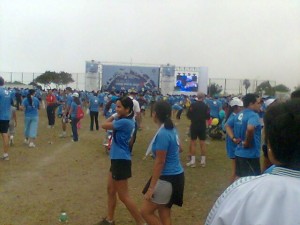 On April 18, 2010, the Dow Live Earth Run for Water took place around the world. The event consisted of a series of 6-km run/walks, which represents the average distance many women and children walk every day to secure water, that took place over the course of 24 hours in countries around the world, featuring concerts and water education activities aimed at igniting a tipping point to help solve the water crisis, as noted in the official web site.
On April 18, 2010, the Dow Live Earth Run for Water took place around the world. The event consisted of a series of 6-km run/walks, which represents the average distance many women and children walk every day to secure water, that took place over the course of 24 hours in countries around the world, featuring concerts and water education activities aimed at igniting a tipping point to help solve the water crisis, as noted in the official web site.
Cities as far as Cape Town, Chicago, Hong Kong, London, Los Angeles, Milan, Melbourne, Mexico City, Minneapolis, New York, Sao Paulo, Toronto, Singapore, Stockholm, Rio de Janeiro, Washington DC., Manchester, and others were part of this big crusade for awareness.
Lima, the Peruvian capital, was not an exception. That Sunday, early in the morning, the district of Miraflores welcomed all the runners and walkers participating in the run.

Starting point – Miraflores city hall at the back

Starting point from another perspective
Paradero 20 [es], a blog with several authors and collaborators, begins its post published the day before the race, by saying:
Sí generamos conciencia, generamos un cambio. El mundo sufre de escasez de agua. Países como Irak, Siria, Jordania y algunas zonas de Turquía y Líbano han sufrido los devastadores efectos de la peor sequía que el Medio Oriente ha vivido en décadas. Sin ir muy lejos, en el Perú la pérdida de reservas de nieve y pronósticos de poca lluvia nos podrían dar el mismo panorama.
The blogger from Hola es un Gusto [es] shares the reasons why she supports this cause stating:
Por eso apoyamos “Corre por el agua 6k”, carrera que tenemos la obligación de apoyar para generar conciencia sobre un recurso sin el cual la vida no sería posible.
Angélica Pereyra from the blog El Contact [es] added a video and the following message:
Más de 190 ciudades participan el mismo día del mayor evento mundial para solucionar la crisis del agua. Sumate!!
Live Earth stated that each year, 1.8 million people (90% of them are children under the age of 5) die of diarrhea. By 2025, two thirds of world population might live in stress situation due to the lack of water.

Finishing line
In Peru, water access has increased from 30 to 63% in the past 28 years. And there have been advances concerning the disinfection of drinking water and in sewage treatment. Although, many challenges still remain, from Wikipedia:
- Insufficient service coverage.
- Deficient sustainability of built systems.
- Tariffs that do not cover the investment and operational costs, as well as the maintenance of services.
- Institutional and financial weakness.
- Excess of human resources, poorly qualified, and high staff turnover.
Besides that, it is always important to raise awareness in the population about the importance of the rational use of this vital natural resource.
Note: all pictures were taken by the author.







1 comment